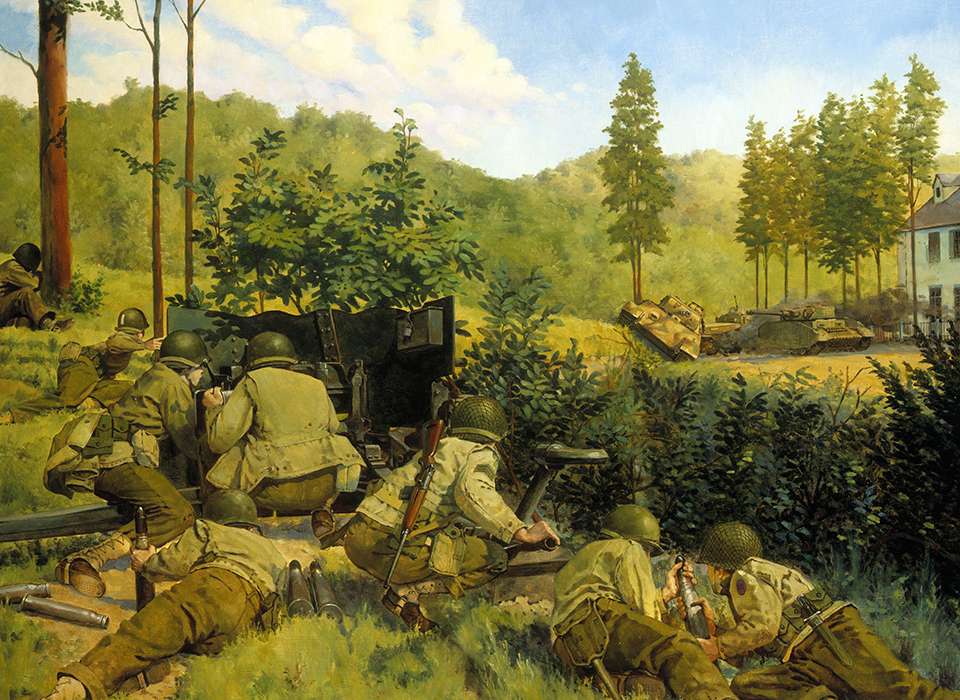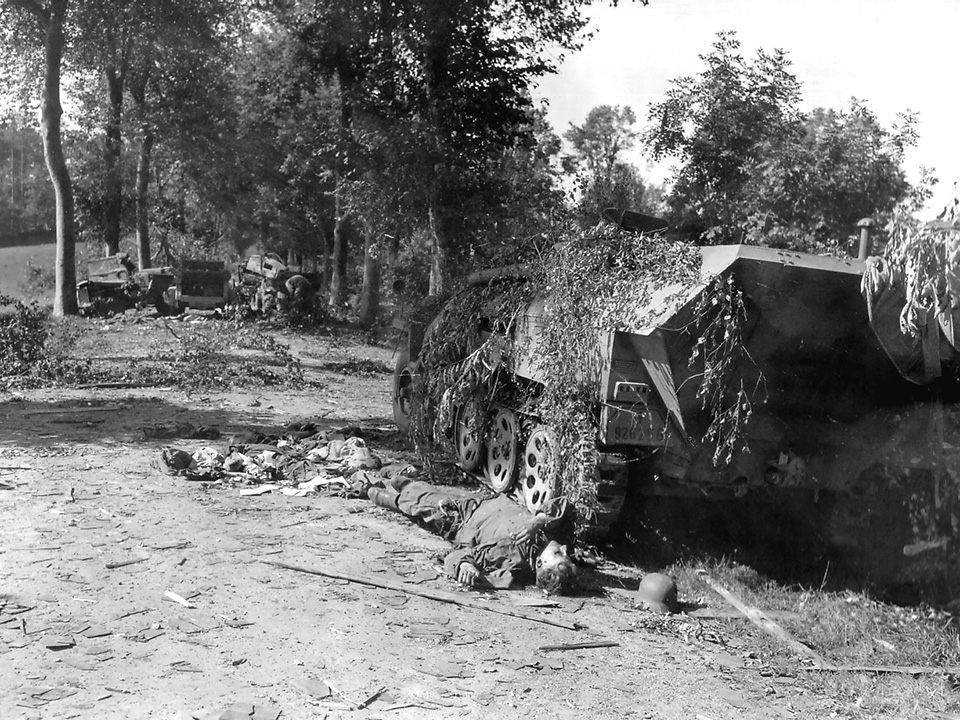Top Image: The 30th Division at Mortain, August 1944, by Keith Rocco. Courtesy of The National Guard.
On March 17, 2020, President Donald J. Trump announced that the US Army will be awarding the Presidential Unit Citation to the 30th Infantry Division, in recognition of its heroic stand at the Battle of Mortain, France, August 7-12, 1944. According to the announcement, “This action rightfully recognizes our veterans who triumphed against incredible odds, as well as those who died during a critical battle that helped ensure the Allied victory in Europe.”
The 30th Division’s distinguished combat record stretches back to World War I, when it was formed as an Army National Guard unit drawn from Tennessee, Georgia, and the Carolinas, and informally dubbed the “Old Hickory” Division. It helped to break Germany’s Hindenburg Line in September-October 1918. The 30th Division returned to Europe during World War II under the command of Major General Leland Hobbs, landing on Normandy’s Omaha Beach on June 11, 1944, and proceeding to the base of the Cotentin Peninsula, where it was deployed in the vicinity of St. Lô. The division subsequently played an important role in Operation Cobra, which commenced on July 25 and led to the American breakout from Normandy.
The advance that followed culminated in the capture of Avranches at the Cotentin Peninsula’s southwestern edge, followed by the activation of Lieutenant General George S. Patton’s Third Army and the deployment of American armored units for the liberation of Brittany. German forces fought desperately to seal the gap at Avranches. Major General Lawton J. Collins’s VII Corps nevertheless held on, and on August 3 the 1st Infantry Division captured the town of Mortain just under twenty miles east of Avranches, widening the gap. Shortly afterwards the 30th Division took over at Mortain, with the mission of holding open the vital corridor against possible enemy counterattack.
That counterattack came on August 7 in the form of a determined assault by tanks of the German XLVII Panzer Corps, ordered by Adolf Hitler to capture Mortain and seize Avranches at all costs, cutting off Patton’s tankers in Brittany. The Old Hickory Division absorbed the brunt of the 2nd SS Panzer Division’s attack. American forward units fought furiously, but their puny 57mm anti-tank guns proved all but useless against the heavy German tanks, forcing the G.I.s to face down the armored behemoths at close quarters with bazookas and any other weapons they could find. The epicenter of the fighting was at Mortain, where the Germans captured the command post of the Old Hickory Division’s 2nd Battalion, 120th Infantry Regiment. East of town, several companies of the battalion were surrounded on Hill 314.
The senior surviving officer, Captain Reynold C. Erichson, took charge of the defense of Hill 314. For five days, the approximately 700 surrounded Americans beat off assaults by the German 17th SS Panzergrenadier Division, despite running severely low on ammunition and almost entirely lacking food and other supplies. 1st Lieutenant Charles A. Barts and 2nd Lieutenant Robert L. Weiss, forward observers with the 230th Field Artillery Battalion, proved critical to the defense. From their vantage point—preserved today within a park on the summit of Hill 314—they enjoyed clear views of German movements on the roads below. Their radioed instructions unleashed devastating American artillery salvoes against the 2nd SS Panzer Division and the 17th SS Panzergrenadier Division, not only degrading enemy assaults on Hill 314 but compromising German efforts to drive on Avranches.
Allied ground attack aircraft inflicted a devastating toll on German tanks, vehicles and infantry, but the small wooded enclave that the 2nd Battalion occupied on Hill 314 proved extremely difficult to resupply by air. Captain Erichson’s men especially needed medical supplies for the increasing numbers of wounded, and batteries for their radios. Finally, the gunners of the 230th Field Artillery Battalion took to firing shell canisters stuffed with supplies into the American lines, helping to alleviate but never fully solving the supply problem.
The battle for Hill 314, part of the larger overall Battle of Mortain, lasted until Captain Erichson’s beleaguered force was relieved on August 12. Four hundred Americans, over half of the total atop the hill, were killed or wounded. But the German offensive had been stopped with heavy casualties, thanks in no small part to the 30th Infantry Division and the heroic stand of the men on Hill 314. The breakout from Normandy would continue, leading to the liberation of Paris and much of France before the end of the month.
Ed Lengel, PhD
Edward G. Lengel is the former Senior Director of Programs for the National WWII Museum’s Institute for the Study of War and Democracy.
Cite this article:
MLA Citation:
APA Citation:
Chicago Style Citation:






![Max Fuchs, New York City cantor, sings as Rabbi Sydney [sic] Lefkowitz, Richmond, VA, conducts the first Jewish services from Germany.](/sites/default/files/styles/max_650x650/public/2025-10/image1.jpg)



